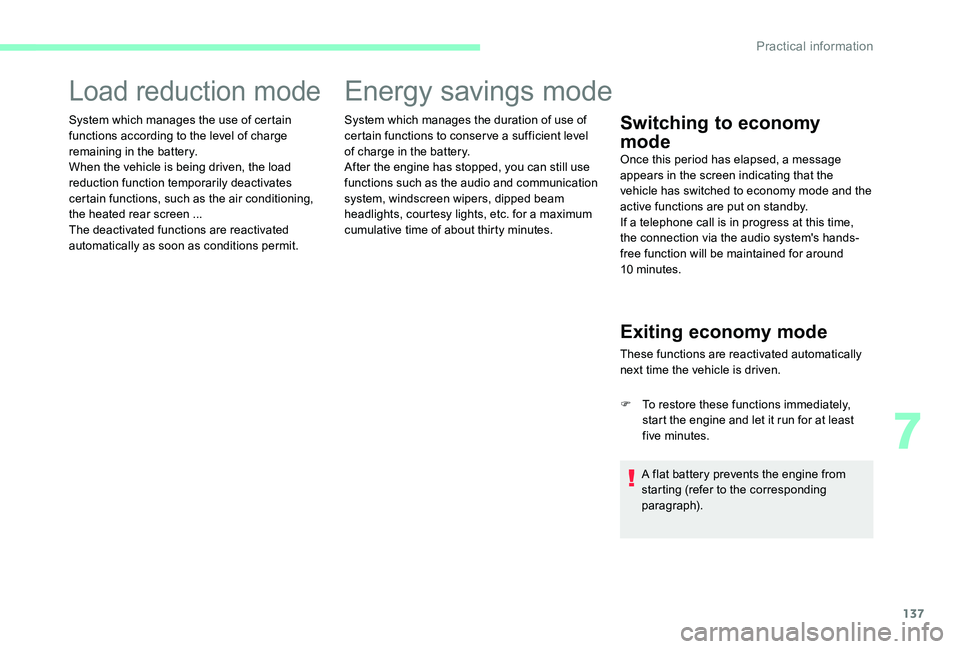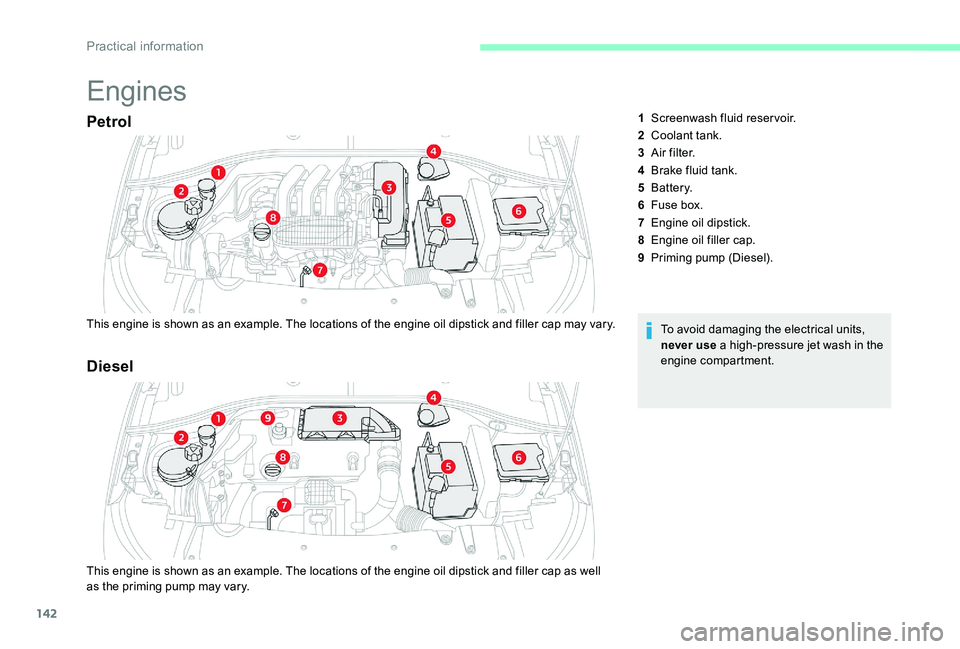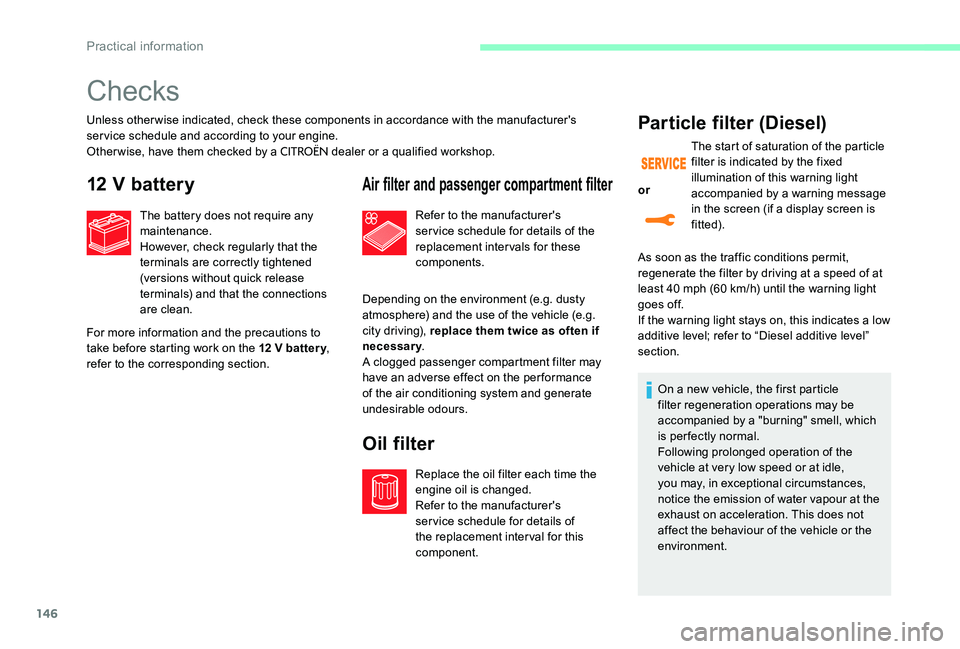battery CITROEN C-ELYSÉE 2017 Handbook (in English)
[x] Cancel search | Manufacturer: CITROEN, Model Year: 2017, Model line: C-ELYSÉE, Model: CITROEN C-ELYSÉE 2017Pages: 306, PDF Size: 9.34 MB
Page 104 of 306

102
Starting-switching off the engine
Anti-theft protection
Electronic engine immobiliser
The key contains an electronic chip which has
a special code. When the ignition is switched
on, this code must be recognised in order for
starting to be possible.
This electronic engine immobiliser locks the
engine management system a few minutes
after the ignition is switched off, and prevents
the engine being started by anyone who does
not have the key.
or In the event of a fault, you are
informed by the illumination of this
warning light, an audible signal and
a message in the screen.
In this case, your vehicle will not start; contact
a
CITROËN dealer as soon as possible.
Keep safely, away from your vehicle, the
label attached to the keys given to you on
when you purchased your vehicle.
Key star ter
It has 3 positions:
- position 1 (Stop): insert and removing the
key, steering column locked,
-
position 2 (Ignition on) : steering column
unlocked, ignition on, Diesel preheating,
engine running,
-
position 3 (Starting) .
Ignition on position
It allows the use of the vehicle's electric
equipment or portable devices to be charged.
Once the state of charge of the battery drops
to the reserve level, the system switches to
energy economy mode: the power supply is
cut off automatically to preserve the remaining
battery charge.
Avoid attaching heavy objects to the key
or the remote control, which would weigh
down on its blade in the ignition switch
and could cause a malfunction.
It could adversely affect the deployment of
the front airbag.
Driving
Page 111 of 306

109
Stopping the vehicle
Before switching off the engine, you can:
- m ove to position N to engage neutral,
or
-
l
eave the gear engaged; in this case, it will
not be possible to move the vehicle.
For all parking situations, you must apply
the parking brake to immobilise the
vehicle.
In case of immobilization of the vehicle,
engine running, absolutely put the gearbox
in neutral N .
Before working in the engine
compartment, ensure that the gear
selector is in neutral N and the parking
brake is applied.
Reinitialisation
Following disconnection of the battery, you
have to reinitialise the gearbox.
F
S
witch on the ignition.AUTO and - appear in the
instrument cluster.
F
Sel
ect position N .
F
P
ress the brake pedal.
F
W
ait for approximately 30 seconds until N
or a gear appears in the instrument cluster.
F
M
ove the gear selector to position A , then
to position N .
F
W
ith your foot still on the brake pedal, start
the engine.
The gearbox is operational again. Exceptionally, it may be necessary to
reinitialise the gearbox automatically: in
such a case the vehicle won't start and no
gear change will happen.
Malfunction
or
With the ignition on, if this warning
light comes on and AUTO
flashes,
accompanied by an audible signal
and a message in the multifunction
screen, this indicates a gearbox
fault.
Have them checked by a
CITROËN dealer or a
qualified workshop. AUTO
and - appear in the
instrument cluster.
Follow the procedure described above.
6
Driving
Page 116 of 306

114
Stopping the vehicle
Before switching off the engine, you can
engage position P or N to place the gearbox in
neutral.
In both cases, apply the parking brake to
immobilise the vehicle.If the selector is not in position P , when the
driver's door is opened or approximately
45 seconds after the ignition is switched
off, a warning message appears in the
screen.
F
R
eturn the selector to position P ; the
message disappears.
When driving on flooded roads or when
crossing a ford, proceed at walking pace.
Malfunction
or When the ignition is on, the lighting
of this warning light, accompanied
by an audible signal and a message
in the screen, indicates a gearbox
fault.
In this case, the gearbox goes into back-up
mode by staying in 3rd gear. You may feel a
substantial knock when changing from P to
R and from N to R . This will not cause any
damage to the gearbox.
Do not exceed 60 mph (100 km/h), local speed
restrictions permitting.
Contact a
CITROËN dealer or a qualified
workshop as soon as possible. There is a risk of damage to the gearbox:
-
i
f you press the accelerator and brake
pedals at the same time,
-
i
f you force the movement of the
selector from the P position to another
position when the battery is dead.
To reduce fuel consumption when at
a prolonged standstill with the engine
running (traffic jam, etc.), put the
selector in the N position and apply the
parking brake.
Driving
Page 118 of 306

116
Stop & Start
The Stop & Start system puts the engine
temporarily into standby - STOP mode - during
stops in the traffic (red lights, traffic jams, or
other...). The engine restarts automatically -
START mode - as soon as you want to move
off. Restarting occurs instantly, quickly and
silently.
Per fect for urban use, the Stop & Start system
reduces fuel consumption and exhaust
emissions as well as the noise level when
stationary.Operation
Going into engine STOP mode
For your comfort, during parking
manoeuvres, STOP mode is not available
for a few seconds after coming out of
reverse gear.
The STOP mode does not affect the
operation of vehicle systems such as
braking, power steering...
Never refuel with the engine in STOP
mode; you must switch off the ignition
using the key.With an electronic gearbox, the
"ECO" indicator illuminates in the
instrument panel and the engine
goes into standby when and the
brake pedal is pressed or the gear
selector is moved into position N
while the vehicle is stationary.
Special cases: STOP mode not
available
STOP mode is not invoked when:
-
T he driver's door is open.
-
T
he driver's seat belt is not fastened.
-
T
he engine is needed to maintain a
comfortable temperature in the passenger
compartment.
-
D
emisting is active.
-
S
ome special conditions (battery charge,
engine temperature, braking assistance,
climate control...) need it to control the
system.
The "ECO" warning light flashes for
a few seconds, then goes off.
This operation is perfectly normal.
Driving
Page 119 of 306

117
Manual deactivation /
reactivation
In certain circumstances, such as the need
to maintain the temperature in the passenger
compartment, it may be useful to deactivate the
Stop & Start system.
The system can be deactivated at any time,
once the ignition is switched on.
If the engine is in STOP mode, it then restarts.
The Stop & Start system is reactivated
automatically every time the ignition is switched
on.Going into engine START mode
- you release the brake pedal with the gear selector in position A or M ,
-
y
ou are in position N with the brake pedal
released and you move the gear selector to
position A or M,
-
y
ou engage reverse.With an electronic gearbox, the
"ECO" warning light goes off and the
engine restarts automatically when:
Special cases: START mode
invoked automatically
As a safety measure or to maintain comfort
levels in the vehicle, START mode is invoked
automatically when:
-
Y
ou open the driver's door.
-
Y
ou unfasten the driver's seat belt.
-
T
he speed of the vehicle exceeds 2 mph
(3
km/h) with an electronic gearbox.
-
S
ome specific conditions (battery charge,
engine temperature, braking assistance,
climate control, etc.) need it to ensure
control of a system or the vehicle.
The "ECO" warning light flashes for
a few seconds, then goes off.
This operation is perfectly normal.
6
Driving
Page 120 of 306

118
With button
Press this button to deactivate the system.
Deactivation is confirmed by the illumination of
the indicator light of the button and the display
of a message.
Pressing the button again reactivates the
system.
The indicator light of the button goes off,
accompanied by the display of a message.
With the touch screen
Press MENU.
In the Driving / Vehicle menu, activate/
deactivate " Stop and Star t System ".
Opening the bonnet
Driving on flooded roads
Before driving through a flooded road, it is
strongly recommended that you deactivate
the Stop & Start.
For more information on Driving advice ,
particularly on flooded roads, refer to the
corresponding section. Before doing anything under the bonnet,
deactivate the Stop & Start system to
avoid the risk of injury related to an
automatic change to START mode.
Malfunction
In the event of a fault in the system,
the indicator light in the "ECO OFF"
button flashes for a moment, then
illuminates continuously.
Have them checked by a
CITROËN dealer or a
qualified workshop.
In the event of a fault in STOP mode, the
vehicle may stall. All of the instrument panel
warning lights come on. It is then necessary to
switch the ignition off and to restart the engine
using the key.
The Stop & Start system requires a
12
V battery of specific technology and
specification.
All work on this type of battery must be
carried out only by a
CITROËN dealer or a
qualified workshop.
For more information on the 12 V batter y ,
refer to the corresponding section.
Driving
Page 139 of 306

137
Load reduction mode
System which manages the use of certain
functions according to the level of charge
remaining in the battery.
When the vehicle is being driven, the load
reduction function temporarily deactivates
certain functions, such as the air conditioning,
the heated rear screen ...
The deactivated functions are reactivated
automatically as soon as conditions permit.
Energy savings mode
System which manages the duration of use of
certain functions to conserve a sufficient level
of charge in the battery.
After the engine has stopped, you can still use
functions such as the audio and communication
system, windscreen wipers, dipped beam
headlights, courtesy lights, etc. for a maximum
cumulative time of about thirty minutes.Switching to economy
mode
Once this period has elapsed, a message
appears in the screen indicating that the
vehicle has switched to economy mode and the
active functions are put on standby.
If a telephone call is in progress at this time,
the connection via the audio system's hands-
free function will be maintained for around
10
minutes.
Exiting economy mode
These functions are reactivated automatically
next time the vehicle is driven.
F
T
o restore these functions immediately,
start the engine and let it run for at least
five minutes.
A flat battery prevents the engine from
starting (refer to the corresponding
paragraph).
7
Practical information
Page 144 of 306

142
Engines
Petrol
This engine is shown as an example. The locations of the engine oil dipstick and filler cap may vary.To avoid damaging the electrical units,
never use a high-pressure jet wash in the
engine compartment.
Diesel
This engine is shown as an example. The locations of the engine oil dipstick and filler cap as well
as the priming pump may vary.1
Screenwash fluid reservoir.
2 Coolant tank.
3 A i r f i l t e r.
4 Brake fluid tank.
5 Battery.
6 Fuse box.
7 Engine oil dipstick.
8 Engine oil filler cap.
9 Priming pump (Diesel).
Practical information
Page 148 of 306

146
Checks
Unless otherwise indicated, check these components in accordance with the manufacturer's
service schedule and according to your engine.
Other wise, have them checked by a
CITROËN dealer or a qualified workshop.
12 V battery
For more information and the precautions to
take before starting work on the 12 V batter y,
refer to the corresponding section. The battery does not require any
maintenance.
However, check regularly that the
terminals are correctly tightened
(versions without quick release
terminals) and that the connections
are clean.
Air filter and passenger compartment filter
Depending on the environment (e.g. dusty
atmosphere) and the use of the vehicle (e.g.
city driving), replace them twice as often if
necessary
.
A clogged passenger compartment filter may
have an adverse effect on the per formance
of the air conditioning system and generate
undesirable odours. Refer to the manufacturer's
service schedule for details of the
replacement intervals for these
components.
Oil filter
Replace the oil filter each time the
engine oil is changed.
Refer to the manufacturer's
service schedule for details of
the replacement interval for this
component.
Particle filter (Diesel)
As soon as the traffic conditions permit,
regenerate the filter by driving at a speed of at
least 40 mph (60 km/h) until the warning light
goes off.
If the warning light stays on, this indicates a low
additive level; refer to “Diesel additive level”
section. or
The start of saturation of the particle
filter is indicated by the fixed
illumination of this warning light
accompanied by a warning message
in the screen (if a display screen is
fitted).
On a new vehicle, the first particle
filter regeneration operations may be
accompanied by a "burning" smell, which
is per fectly normal.
Following prolonged operation of the
vehicle at very low speed or at idle,
you may, in exceptional circumstances,
notice the emission of water vapour at the
exhaust on acceleration. This does not
affect the behaviour of the vehicle or the
environment.
Practical information
Page 173 of 306

171
Fuse in the engine
compartment
The fusebox is placed in the engine
compartment near the battery (left-hand side).
Access to the fuses
F Unclip the cover
F C hange the fuse.
F
W
hen you have finished, close the cover
very carefully to ensure correct sealing of
the fusebox. Fuse no.
Rating Functions
F14 15 AHeated lower windscreen.
F15 5 AAir conditioning compressor.
F16 15 AFront fog lamps.
F18 10 A
Right-hand main beam headlamp.
F19 10 A
Left-hand main beam headlamp.
F29 40 A
Front wiper motor.
F30 80 APre-heater plugs (Diesel).
8
In the event of a breakdown